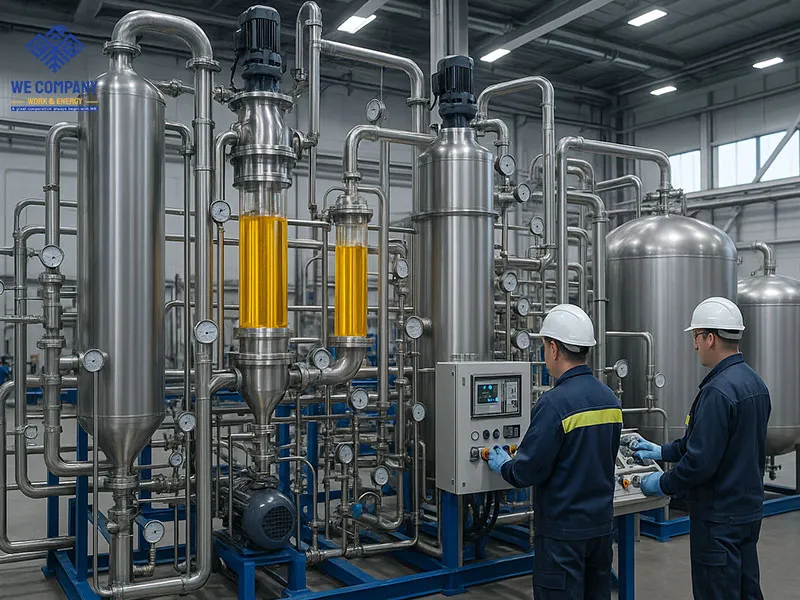Turning Used Lube Oil into High‑Grade Base Oil with Thin Film Distillation (TFD)
1. Introduction: The Value of Re‑Refined Base Oil
Sustainability and supply security are reshaping the industrial oil market. Re‑refined base oils—derived from used lubricating oil (ULO)—offer a pathway to reduce waste, cut supply costs, and meet environmental goals. But not all re‑refining methods deliver production‑grade quality. Enter Thin Film Distillation (TFD) (also known as Wiped Film Evaporation (WFE)), a refining process that produces high‑purity, high‑performance base oil fractions—like SN‑150, SN‑500, and SN‑600—comparable to Group I virgin stocks.
This article explores:
- What TFD is and why it works better
- A technical breakdown of TFD-based production
- Key benefits and applications in diverse industries
- A buyer’s checklist for sourcing re‑refined base oil
- Why Work & Energy Co. is a trusted supplier of SN‑150, SN‑500, and SN‑600 base oils via TFD
2. Why Thin Film Distillation (TFD) Excels
2.1 How TFD Works Versus Conventional Re‑Refining
Traditional re‑refining often uses vacuum distillation or clay treatment alone—still effective, but limited. Thin Film Distillation (TFD) uses:
- Deep vacuum (low pressure) to reduce boiling temperatures
- A wiper system to spread oil into an ultrathin film on heated surfaces
- Very short residence time, protecting heat-sensitive molecules
These features produce:
- Minimum thermal cracking and degradation
- Efficient removal of heavy ends and contaminants
- Superior product stability and clarity
2.2 Technical Advantages of TFD‑Derived Base Oils
| Benefit | Description |
|---|---|
| High purity & color | Produces bright, clear fluids with reduced color index (near ASTM color < 1) |
| Low sulfur & TAN | Lower acid number and sulfur ppm foster cleaner formulations |
| Precise viscosity control | Enables tight ranges for KV@40°C and VI—ideal for SN 150 / SN 500 |
| Low odor & volatiles | Critical for sensitive sectors like cosmetics and food-grade waxes |
| Oxidation stability | Enhanced by minimizing residual polar contaminants |
3. Step‑by‑Step: From Used Oil to Refined Base Stock
3.1 Pre‑Treatment & Dehydration
The feedstock enters filtration, demetallization, and dehydration steps:
- Water removal below 500 ppm to prevent hydrolysis
- Demetallization (acid clay or ion exchange) to strip heavy metals
This protects downstream equipment and ensures consistent feed quality.
3.2 Vacuum Distillation (Primary Cut)
Under reduced pressure, lighter ends (solvents, light fractions) are removed. The goal is to isolate the lube-range fraction—destined for further purification via TFD.
3.3 Core Step: Thin Film (Wiped Film) Evaporation
Inside the TFD unit:
- A rotating wiper spreads oil as a thin film on heated surfaces
- Under high vacuum, volatile molecules evaporate rapidly and condense elsewhere
- The distillate is the refined base oil fraction; non-volatile residue contains sliders, additives, and heavy contamination
This stage delivers premium clarity and purity, with minimal thermal decomposition.
3.4 Hydrofinishing (Hydrotreating)
The distilled fraction passes through a hydrogenation reactor to:
- Remove residual sulfur and nitrogen
- Improve oxidative stability
- Brighten color
Depending on severity (pressure, temperature, catalyst), the outcome can be on par with Group I or II base oil.
3.5 Final Processing: Polishing & Packaging
The hydrofinished oil undergoes:
- Clay filtration to polish color
- Hydrogen peroxide or hydrogen peroxide plus clay to final clarity
- Pour point control via additives or cold filtration
The result: a re‑refined base oil that meets or exceeds SN 150, SN 500, or SN 600 specifications.
4. Applications Across Industries
Industries served:
- Automotive & Industrial Lubricants – High‑performance engine oils, hydraulic fluids, gear oils, and metalworking fluids rely on consistent VI, flash/pour, and low sulfur.
- Grease Manufacturing – SN-based stocks offer consistent thickener response (calcium, lithium, complex greases).
- Rubber & Plastic Processing – Low sulfur/color base oils reduce contamination and improve clarity in rubber compounds.
- Candles & Cosmetics – Clean, low-odor base oils enhance appearance and scent purity.
- Chemical & Process Fluid – Serve as carriers in formulations requiring low impurities.
By harnessing the benefits of Thin Film Distillation, manufacturers can produce base oils tailored to exacting performance and compliance requirements.
5. Buyer’s Checklist: Qualifying Re‑Refined Base Oils
When evaluating suppliers, ensure they can provide:
- Comprehensive Spec Sheets:
Include KV@40/100, VI, color (ASTM), sulfur (ppm), TAN, flash point, pour point, and Noack volatility. - Proof of Process Capability:
Confirm the supplier uses true TFD/WFE technology followed by hydrofinishing—not just atmospheric or vacuum distillation. - Quality Assurance Data:
Request batch COAs (Certificates of Analysis), QC procedures, ISO compliance, and retention samples. - Sustainability Credentials:
Re‑refining supports circular economy initiatives and reduces downstream ecosystem impact (Scope 3 emissions). - Logistics & Packaging:
Verify options—bulk tanker, flexitank, drums, IBC—and paperwork readiness for export.
6. Why Work & Energy Co. Stands Out
Product Range – TFD‑Derived Base Oils:
- SN 150 Base Oil: Ideal for hydraulic oils, MWFs, engine oils needing tight viscosity and purity.
- SN 500 Base Oil: Suited for heavy-duty greases and industrial hydraulic oils.
- SN 600 Base Oil: Heavy cut for lubrication of open gears, heavy machinery.
Technical Edge:
- Operates advanced TSO TFD/WFE units with robust controls for vacuum, temperature, and residence time.
- Incorporates state‑of‑the‑art hydrofinishing for color, sulfur, and stability targets.
Quality & Traceability:
- Full spec series and batch COAs for every delivery.
- ISO-certified, with a QC lab dedicated to VI, TAN, sulfur, and color analysis.
Sustainability:
- Captures and re-refines used oils, reducing waste-to-dump or incineration practices.
- Supports circular economy procurement strategies.
Flexible Delivery & Support:
- Packaging options: bulk flexitank, IBC, drums.
- On-demand technical support for formulation matching, viscosity modeling, and blend recommendations.
7. Conclusion: TFD as the Future of Re‑Refined Base Oils
Thin Film Distillation (TFD) represents a benchmark-proven method to reclaim used lubricating oil as high-quality, specification-grade base oils. Offering purity, precise viscosity, low sulfur, and clean color, TFD-derived SN 150, SN 500, and SN 600 base stocks serve critical applications—from engine oils and greases to rubber additives and cosmetic waxes.
Work & Energy Co., with its TFD-capable units, hydrofinishing, rigorous QC, and sustainability-oriented operations, is an ideal partner for businesses looking to tap into high-performance, circular economy-aligned base oil supplies.
Ready to qualify re‑refined base oil for your formulations?
Contact Work & Energy Co. for full specifications, customized packaging, pricing, and export solutions.






No comment